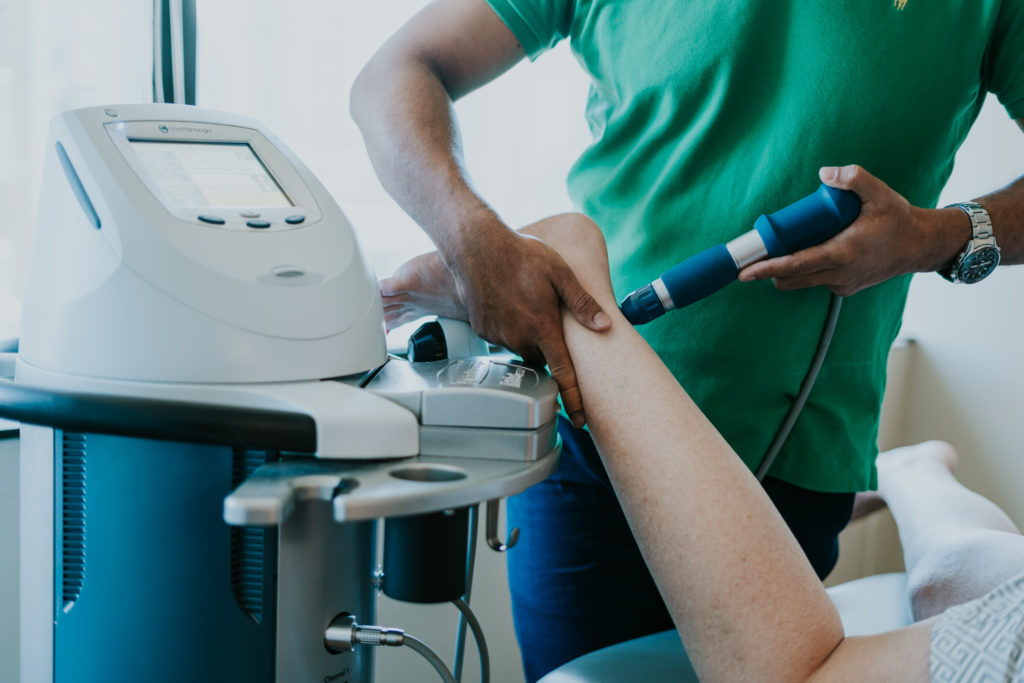Achilles Tendonopathy
Achilles Tendonopathy can be debilitating but…
Burrard Physiotherapy is up on the latest treatment techniques.
The Achilles tendon is the thickest in the body. It attaches the calf muscles to the heel bone (calcaneus). In adults it is about 15 cm long. A Bursa (fat pad) is wedged between the tendon and the calcaneus at the upper junction of the bone and tendon. The bursa cushions the tendon against the bone.
The Achilles tendon can receive load stresses up to 4 times the body weight during walking and almost 8 times body weight during running. These huge stresses are also very repetitive when walking and running, imagine the total load taken on the tendon during a 20 minute walk, let alone a marathon.
Not surprisingly, with the nicer weather, comes more activity for most of us outside and we always see a spike in the number of Achilles injuries through the warmer months.
SYMPTOMS
Because the bursa is so closely linked to the tendon, and under pressure when the tendon is in use, symptoms are very similar. With careful examination your physiotherapist will be able to differentiate between bursitis and tendonopathy. Typically pain is felt 2 – 3 cm above the heel attachment. It often starts slowly, as stiffness felt after a long training session. This develops to a definite pain as the activity contin ues. Eventually the area may become warm and swollen and can limit the ability to even walk nor mally. Occasionally it will start quite suddenly and this is often associated with a sudden, traumatic, partial tearing of the tendon.
PREDISPOSING FACTORS
Some typical background factors increase the tendency to develop this condition:
Poor Preparation—In any running or jump ing sport, starting the season without suffi cient preparation is a major risk factor. Keep the calf muscles stretched and have some basic cardiovascular fitness before the season begins.
Training Errors—Suddenly increasing mile age or hill work especially when combined with failure to warm up correctly and stretch properly. For dancers, sudden increases in jumping or intensity of training.
Footwear and surfaces—For runners, ill fitting, incorrect or worn out shoes, running on cambered roads and poor running style are all-important. For dancers it is often repetitive jumping on hard floors.
Skeletal variation—The over pronated foot is vulnerable as the heel is whipsawed from side to side during the walking or running cycle. This tends to be made worse by a turned out running style.
Age related—Tendon blood supply reduces and connective tissues and shock absorb ing fat pads tend to thin with age. This puts the over 40 athlete at a little more risk.
Direct Trauma—A previous kick, blow or laceration can weaken the tendon.
Weakness around the pelvis and trunk muscles can produce a turned out gait, which tends to increase pronation loading and tendon strain.
Sudden weight gain will also put more stress on the lower limbs.
Management
It is important to seek treatment early to avoid this becoming a chronic condition. The department of Physiotherapy at UBC is currently conduction research into the effectiveness of IMS (needling with acupuncture needles) in the treatment of achillies tendonitis. Recent rehab protocols have been developed by Dr Taunton and his team. And even more recently Shock Wave Therapy has been shown to have significant success in the treatment of chronic tendonopathy.
Our Physiotherapy team has been attending lectures and symposiums regularly on this debilitating and sometimes stubborn condition. BOOK NOW for a full assessment and to discuss your treatment options with us.

